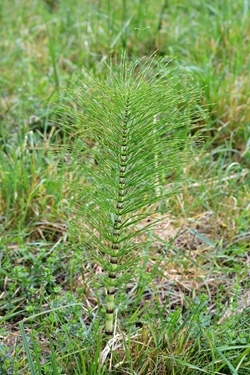Horsetail
 Firstly, let me make quite clear which plant I am talking about here! Many people also call this plant “Mare’s tail”, which strictly speaking is a totally different plant species found in aquatic habitats: Hippurus vulgaris!
Firstly, let me make quite clear which plant I am talking about here! Many people also call this plant “Mare’s tail”, which strictly speaking is a totally different plant species found in aquatic habitats: Hippurus vulgaris!
Horsetail, on the other hand, comes from the family Equisetum (from the Latin equus (“horse”) and seta (“bristle”) and has around eight or so species in the UK. However, they are not always that easy to identify, as they form hybrids and their characteristics can be quite variable.
Horsetail originates from a group of tall plants, some of which grew up to 30 metres tall and were one of the most dominant plants during the Paleozoic era, first appearing some 400 million years ago. To help you put that into some sort of perspective, dinosaurs appeared about 230 million years ago, so you can see just how long this plant has been around! Indeed, fossil findings show us that horsetails have retained multiple ancient features, indicating that this ancient spore-bearing plant could possibly be the oldest living species within today’s vascular plants.
The first stems of horsetail appear in the spring and look a little like asparagus, but with a large brown cone-like structure at the head of the plant, which holds the spores. Later in the year, larger stems emerge with string-like, tough leaves, giving the plant the appearance of a small pine tree, or maybe, if you stretch your imagination somewhat, a little like a horse’s tail.
Horsetail contains more silica within its stems than any other plant in the world. This trace element really helps to bind protein molecules together within the blood vessels and connective tissues and promotes the body’s absorption of calcium, an important component in tissue repair and bone and cartilage formation.
Another common name for horsetails is “scouring rush”, as the plant contains its silica as crystals, making the stems an excellent material for cleaning pots and pans. Historically, people tied bunches of horsetail stems together to form homemade scouring pads, which were particularly favoured for cleaning pewter.
One or two of you may have discovered as children that the stems of horsetail can be broken apart at the junction of each segment and then miraculously put perfectly back together again, giving it the name of “Lego plant”. I wonder if Stone Age children actually played with Lego a long time before we invented it!
I have gone to great lengths to point out how amazing this ancient plant is and how little it has changed over 400 million years, and yet, despite staying largely unchanged over all this time, it still thrives in today’s modern world.
I’m quite sure I have not convinced you all, though, as I am fully aware that if it occurs in your garden or paddock, it can be a real headache to get rid of. (Bruise and crush it, followed by a number of repeat applications of glyphosate will eventually, if you are persistent, bring it under control!)
Just remember, though: it was here long before us!
Peter Thompson
Advisory
Read more from Peter Thompson at his blog.

Download Peter Thompson's essential 26-page book, featuring beautiful photography and detailed profiles of Britain's wildlife
Download FREE >